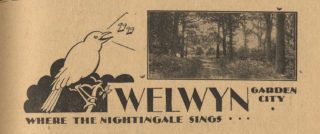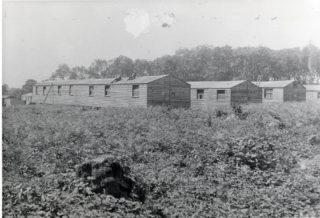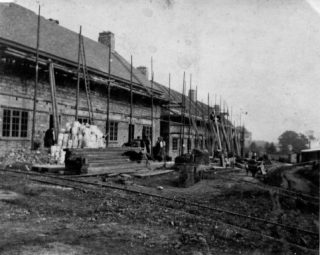Molly Jennings - Part One
Welwyn Garden City's first resident
By Roger Filler
These are the reminiscences of Molly Jennings, the town’s first resident, made in 1969-70.
Since the Old Residents’ dinner a few years ago, when I had a certain amount of publicity as the oldest inhabitant, it is no long any good, me pretending that I am not getting on for ninety.
Nibby
I went to Welwyn, which is now called Old Welwyn, in May 1920, accompanied by my dog Nibby, who some may still be remembered by a very few people as the first dog. I came to see some land near Welwyn Station which was to be sold freehold £60 an acre!
I walked from Welwyn Station to Welwyn village and saw someone about the land, and then I thought that while I was in the neighbourhood I might as well see what was happening about a proposed new Garden City which had been mentioned that week in “Punch” – not in the funny part of the magazine, but among the advertisements.
So Nibby and I left Welwyn village and walked along the Great North Road. We turned left at the Red Lion, went on through the woods, and presently arrived at a place which I think must have been where the golf course now ends.
The Promised Land
Here I had my first view of the promised land. The view, looking south, was much more open than it is now. There were fewer or smaller trees and not a building or anything but open country was to be seen for miles and miles. As for the North Road, I don’t suppose I had met more than a couple of carts or traps and horses all the way. It was lovely spring weather, and my memory of that moment is of standing on a height, looking at meadows, cornfields and hedges which went gently downhill as far as I could see, and it was all in a kind of shimmering light.
I don’t know how I found my way, or how I knew that there would be anything to be seen at the end of it, but I walked down Brockswood Lane, then only a cart track. Most of it was where it is now, but after passing the end of Handside Lane, it followed the old sunken road to the left, the remains of which can still be seen to the left of the main road, just before reaching the Campus. At that point there was a pond on each side of the lane, and the site of one of these ponds is now the front garden of the houses next to the Old Cottage. I wish you could have seen that cottage before somebody tried to improve it.
Handside Village
That, with four cottages at the end of Handside Lane, which have been pulled down, and the cottages which can still be seen near the level crossing, made up the hamlet of Handside, and were the only buildings in the whole countryside, except Brickwall, and Handside farmhouses and farm buildings.
Wooden Huts
I went on past what is now The Campus, and was than all woods, with a workmen’s camp of army huts hidden away somewhere. I arrived at last at another group of army huts also surrounded by woods. These were the Garden City offices.
There was not a soul to be seen, but having come so far, I thought I had better try to see somebody. I had, of course, expected to find crowds of “Punch” readers besieging the office for information.
I plucked up my courage and knocked at the door, and out came Mr Rawlinson, one of the very early landmarks. He looked as if he had seen a ghost, and I realised that instead of one of hundreds of eager applicants I must be an isolated phenomenon.
I suppose I must have looked at some maps and papers – I can’t remember – but is seemed that the next move would be to see the people in the London office. So Mr Rawlinson advised me to go back to Welwyn Station by the old road, over the hill and under the viaduct, and that is what I must have done, though I find it hard to believe. I have never worked out my mileage for that day, but I evidently survived, and so did Nibby, for he lived to bone of the early celebrities, and the bane of the Garden City. I can’t remember, either, what we lived on that day. I am sure I would never have called at what is now known as a “pub”, in fact, I had never even been allowed to soil my lips with such a word.
The return visit
Then, one day in June 1920, I came down again with my husband, Mason, whom many people will remember. We called at the London office on the way, and saw a map with the plot of land where my bungalow now is. We wanted the corner plot at the top of the road, but were told that is was being reserved for a church. That spot, the corner of High Oaks Road and Brockswood Lane, was to be the highest land build on. The height above sea-level was considered to be one of the most attractive features of the Garden City site, and the whole place was to build up that point, and culminate in the church spire.
High Oaks Road
We left the London office and came straight down here to see for ourselves and we were shown the land which was to be High Oaks Road. The only thing to mark its future position was the old country hawthorn hedge, which is still at the end of all the gardens in High Oaks Road.
At the place where the “goldfish” house now is, i.e. Mr and Mrs Scoffams’s, there were the remains of a garden and orchard, with the usual heaps of broken bricks, rusty iron bedsteads, saucepans and old boots – all that remained of the two old cottages which had been there not long before.
From the old hedge we walked down Brockswood Lane, where they were now beginning to dig the foundations of the first group of houses in that area. They were being built by Labour Saving Houses, and are now about numbers 8 to 30.
Molly Jennings story continues in Part Two










Add your comment about this page
I remember Mollie. I am the only surviving child of Arthur and Gwladys Russell Jones.our family were great friends of Mollie and Mason’s. I have cine film of them caravanning with us in. Cornwall . I’m not sure if it’s the same Mr Rawlinson that Mollie met but if so he was a craftsman who as a child I would visit in a hut off Bridge Rd. He made me a lovely mirror, which I still have, with a red and green painted wooden frame.